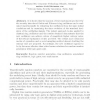Free Online Productivity Tools
i2Speak
i2Symbol
i2OCR
iTex2Img
iWeb2Print
iWeb2Shot
i2Type
iPdf2Split
iPdf2Merge
i2Bopomofo
i2Arabic
i2Style
i2Image
i2PDF
iLatex2Rtf
Sci2ools
CHES
2007
Springer
2007
Springer
High-Speed True Random Number Generation with Logic Gates Only
It is shown that the amount of true randomness produced by the recently introduced Galois and Fibonacci ring oscillators can be evaluated experimentally by restarting the oscillators from the same initial conditions and by examining the time evolution of the standard deviation of the oscillating signals. The restart approach is also applied to classical ring oscillators and the results obtained demonstrate that the new oscillators can achieve orders of magnitude higher entropy rates. A theoretical explanation is also provided. The restart and continuous modes of operation and a novel sampling method almost doubling the entropy rate are proposed. Accordingly, the new oscillators appear to be by far more effective than other known solutions for random number generation with logic gates only.
| Added | 07 Jun 2010 |
| Updated | 07 Jun 2010 |
| Type | Conference |
| Year | 2007 |
| Where | CHES |
| Authors | Markus Dichtl, Jovan Dj. Golic |
Comments (0)

